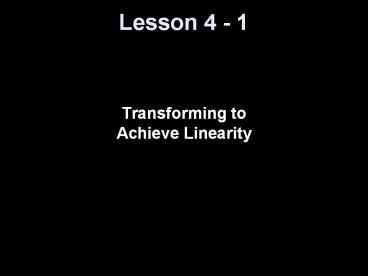Transforming to Achieve Linearity PowerPoint PPT Presentation
1 / 14
Title: Transforming to Achieve Linearity
1
Lesson 4 - 1
- Transforming to Achieve Linearity
2
Knowledge Objectives
- Explain what is meant by transforming
(re-expressing) data. - Tell where y log(x) fits into the hierarchy of
power transformations. - Explain the ladder of power transformations.
- Explain how linear growth differs from
exponential growth.
3
Construction Objectives
- Discuss the advantages of transforming nonlinear
data - Identify real-life situations in which a
transformation can be used to linearize data from
an exponential growth model - Use a logarithmic transformation to linearize a
data set that can be modeled by an exponential
model - Identify situations in which a transformation is
required to linearize a power model - Use a transformation to linearize a data set that
can be modeled by a power model
4
Vocabulary
- Exponential Growth
- Hierarchy of Power Transformations
- Ladder of Power Transformations
- Linear Growth
- Logarithmic Transformation
- Power Model
- Transformation
5
Brain wt vs Body Wt
Direction positive Form ? linear
? Strength moderate Outliers y Human
Dolphin x Hippo Elelphant Clusters
maybe near 600
6
Mammals - Outliers Removed
Direction positive Form curved Strength
moderate Outliers y 2 upper dots Clusters
maybe ?
7
Scatter plot and LS Regression
8
Data Transformations
- From our calculator
- Linear Regression y-hat a b x
- Quadratic Regression
- Cubic Regression
- Quartic Regression
- Natural Log Regression y-hat a b ln(x)
- Exponential Regression
- Power Regression y-hat axb
- Logistic Regression
- Sinusoidal Regression
- Only these 3 do we need be concerned with
9
Transforming with Powers
- Form xn where n is a number
- For n 1 we have a line
- For n gt 1 we have curves that bend upward
- For 0 lt n lt 1 we have curves that bend downward
- For n lt 0 we have curves that decrease as x
increases (the bigger the negative the quicker
the decrease)
, x-2, x-1, x-½, x½, x, x2, x3,
10
Hierarchy of Power Functions
n 0 corresponds to the logarithm function
11
Trial and Error is not Recommended
12
Real-Life What do you do?
- We begin with a mathematical model that we expect
the data to adhere to (experience is the key!) - Linear growth is an additive process
- Exponential growth is a multiplicative process
13
Laws of Logs
14
Summary and Homework
- Summary
- Homework
- pg

